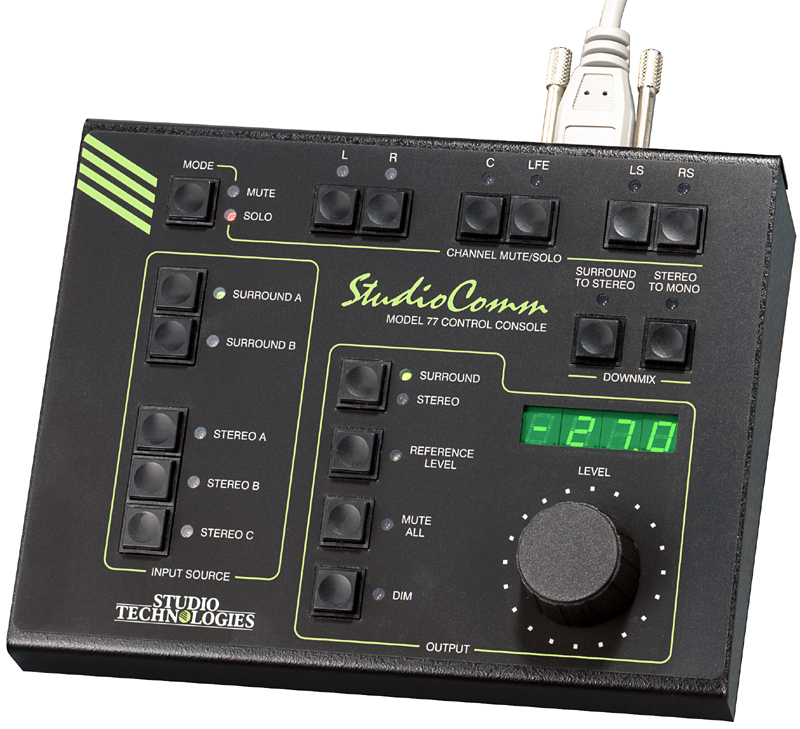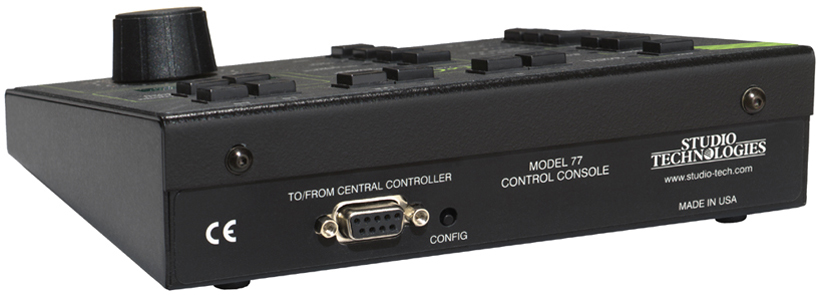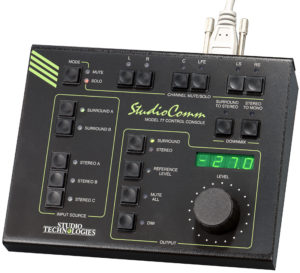Model 76DA Central Controller
General Audio:
Supported Sample Rates: 32, 44.1, 48, 88.2, 96, 176.4, and 192 kHz
Word Length: 24 bits maximum
Internal Processing: 32 bits
Input-to-Output Latency: two samples (e.g., 0.042 milliseconds @ 48 kHz sample rate)
Digital Audio Inputs: 5 (18 audio channels)
Configuration: two surround (5.1) and three stereo
Type: AES3 unbalanced (75 ohms/1 Vpp)
Connectors: BNC (per IEC 60169-8 Amendment 2)
Sample Rate Conversion (SRC):
Application: available on Stereo Input C
Input Sample Rate Range: 8 to 216 kHz, limited to 1/6 to 6 times the output sample rate
Latency: 1 millisecond, nominal
Sync Source: configured to follow L/R of currently selected input or signal connected to sync input
Sync Input:
Compatible Sources: word clock, DARS (AES11), bi-level video, tri-level video
Jitter: 4 ns pp maximum
Connector: BNC (per IEC 60169-8 Amendment 2)
Termination: 75 ohms, selectable on/off
Digital Monitor Outputs: 16 (eight pairs)
Configuration: organized as two surround (5.1) and two stereo
Dynamic Range: >135 dB
Type: AES3 balanced (110 ohms/5 Vpp) or unbalanced (75 ohms/1 Vpp), selectable
Connector: 25-pin female D-subminiature (DB-25F)
Analog Monitor Outputs: 8
Configuration: organized as one surround (5.1) and one stereo (2-channel)
Type: electronically balanced, source impedance 200 ohms
Nominal Level: +4.0 dBu @ –20 dBFS input source and level control at maximum setting
Maximum Level: +24 dBu into 2000 (2 k) ohms or greater
Frequency Response, Digital Inputs to Analog Monitor Outputs: 10 Hz-20 kHz +0.0/–0.3 dB @ 48 kHz sample rate; –3 dB @ 64 kHz
Distortion (THD+N): <0.002%, –1 dBFS, 20-22 kHz, 22 kHz bandwidth
S/N Ratio: 89 dB, ref +4 dBu output
Dynamic Range: >109 dB
Crosstalk: –98 dB at 1 kHz; –97 dB at 16 kHz, ref –1 dBFS input
Connector: 25-pin female D-subminiature (DB-25F)
Configurable Input Delay: 0 to 340 milliseconds @ 48 kHz sample rate (scales up or down depending on actual sample rate)
Post-Fader Monitor Output Level Offsets: each surround and stereo channel independently adjustable in 0.5-dB steps over a ±12-dB range. (Digital and analog outputs associated with a specific channel share the same setting.)
Bass Management:
Supported Sample Rates: 44.1, 48, 88.2, and 96 kHz only
Crossover Frequency and Type: –6 dB @ 40, 50, 60, or 80 Hz, symmetrical for low-pass and high-pass filters, maximally flat
Filter Slope: 12 or 24 dB/octave
Overall Operation: independent on/off selectable for surround and stereo post-fader monitor outputs
Downmix:
Functions: surround to stereo, stereo to mono
Surround to Stereo:
L @ 0 or –3 dB;
R @ 0 or –3 dB;
C @ –3 or –6 dB summed with L and R;
LFE @ full attenuation or –6 dB summed with L and R;
LS @ –3 or –6 dB summed with L;
RS @ –3 or –6 dB summed with R;
C, SUB, LS, and RS monitor outputs mute
Stereo to Mono:
L @ –3 dB summed with R @ –3 dB to C;
L, R, LS, RS, and SUB monitor outputs mute
For a surround input this results in the C output being the sum of L @ –3 or –6 dB, R @ –3 or –6 dB; C @ –3 or –6 dB, LFE @ full attenuation or –6 dB; LS @ –6 or –9 dB, and RS @ –6 or –9 dB.
Control Console Interface:
Type: RS-485, 115.2 kbit/s, 8-1-N
Polling Interval: 50 milliseconds
Power: 12 Vdc, 500 mA maximum
Connector: 9-pin female D-subminiature (DE-9F)
Remote Control Inputs: 2
Functions: remote mute all, remote dim
Type: 5 Vdc logic, activates on closure to system common
Connector: 9-pin female D-subminiature (DE-9F)
AC Mains:
Requirement: 100 to 230 V, +10/–15%, 50/60 Hz, 15 W maximum
Connector: 3-blade, IEC 320 C14-compatible (mates with IEC 320 C13)
Dimensions:
19.00 inches wide (48.3 cm)
1.72 inches high (4.4 cm)
7.00 inches deep (17.8 cm)
Mounting: one space (1U) in a standard 19-inch rack
Weight: 3.6 pounds (1.6 kg)
Model 77 Control Console
Application: up to four Model 77 Control Consoles can be connected to a Model 76DA Central Controller
Power: 12 Vdc nominal (9 Vdc minimum), maximum current 100 mA, provided by Model 76DA Central Controller
Control Data:
Type: RS-485
Data Rate/Format: 115.2 kbit/s, 8-N-1
Connector: 9-pin female D-subminiature (DE-9F)
Dimensions (Overall):
7.20 inches wide (18.3 cm)
2.20 inches high (5.6 cm)
5.40 inches deep (13.7 cm)
Weight: 1.7 pounds (0.8 kg)
Model 71 Control Console
Application: up to three Model 71 Control Consoles can be connected to a Model 76DA Central Controller
Power: 12 Vdc nominal (9 Vdc minimum), maximum current 35 mA, provided by Model 76DA Central Controller
Control Data:
Type: RS-485
Data Rate/Format: 115.2 kbit/s, 8-N-1
Connector: 9-pin female D-subminiature (DE-9F)
Dimensions (Overall):
3.20 inches wide (8.1 cm)
2.20 inches high (5.6 cm)
4.10 inches deep (10.4 cm)
Weight: 0.8 pounds (0.4 kg)
Specifications subject to change without notice.









